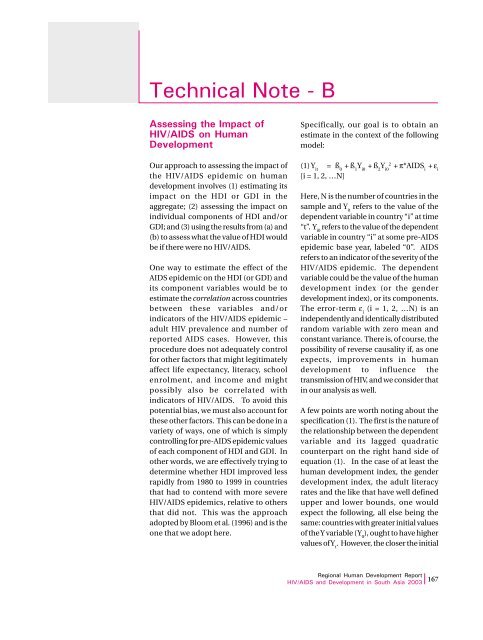Download Report - UNDP Asia-Pacific Regional Centre - United ...
Download Report - UNDP Asia-Pacific Regional Centre - United ...
Download Report - UNDP Asia-Pacific Regional Centre - United ...
Create successful ePaper yourself
Turn your PDF publications into a flip-book with our unique Google optimized e-Paper software.
Technical Note - BTechnical Note - BAssessing the Impact ofHIV/AIDS on HumanDevelopmentOur approach to assessing the impact ofthe HIV/AIDS epidemic on humandevelopment involves (1) estimating itsimpact on the HDI or GDI in theaggregate; (2) assessing the impact onindividual components of HDI and/orGDI; and (3) using the results from (a) and(b) to assess what the value of HDI wouldbe if there were no HIV/AIDS.One way to estimate the effect of theAIDS epidemic on the HDI (or GDI) andits component variables would be toestimate the correlation across countriesbetween these variables and/orindicators of the HIV/AIDS epidemic –adult HIV prevalence and number ofreported AIDS cases. However, thisprocedure does not adequately controlfor other factors that might legitimatelyaffect life expectancy, literacy, schoolenrolment, and income and mightpossibly also be correlated withindicators of HIV/AIDS. To avoid thispotential bias, we must also account forthese other factors. This can be done in avariety of ways, one of which is simplycontrolling for pre-AIDS epidemic valuesof each component of HDI and GDI. Inother words, we are effectively trying todetermine whether HDI improved lessrapidly from 1980 to 1999 in countriesthat had to contend with more severeHIV/AIDS epidemics, relative to othersthat did not. This was the approachadopted by Bloom et al. (1996) and is theone that we adopt here.Specifically, our goal is to obtain anestimate in the context of the followingmodel:(1) Y it= ß 0+ ß 1Y i0+ ß 2Y i02+ π*AIDS i+ ε i[i = 1, 2, …N]Here, N is the number of countries in thesample and Y itrefers to the value of thedependent variable in country “i” at time“t”. Y i0refers to the value of the dependentvariable in country “i” at some pre-AIDSepidemic base year, labeled “0”. AIDSrefers to an indicator of the severity of theHIV/AIDS epidemic. The dependentvariable could be the value of the humandevelopment index (or the genderdevelopment index), or its components.The error-term ε i(i = 1, 2, …N) is anindependently and identically distributedrandom variable with zero mean andconstant variance. There is, of course, thepossibility of reverse causality if, as oneexpects, improvements in humandevelopment to influence thetransmission of HIV, and we consider thatin our analysis as well.A few points are worth noting about thespecification (1). The first is the nature ofthe relationship between the dependentvariable and its lagged quadraticcounterpart on the right hand side ofequation (1). In the case of at least thehuman development index, the genderdevelopment index, the adult literacyrates and the like that have well definedupper and lower bounds, one wouldexpect the following, all else being thesame: countries with greater initial valuesof the Y variable (Y 0), ought to have highervalues of Y t. However, the closer the initial<strong>Regional</strong> Human Development <strong>Report</strong>HIV/AIDS and Development in South <strong>Asia</strong> 2003 167
















